Top 10 Texas Wildflowers to Grow
Starting as early as February, beautiful Texas wildflowers begin appearing along roadsides and fields in the Texas Hill Country area where I live. Central Texas is one of the best spring wildflower spots in the United States!
Want to grow wildflowers at home? Then start by downloading this FREE 10 Texas Wildflowers PDF. It includes a photo of each along with growing info including bloom period and sun requirements.
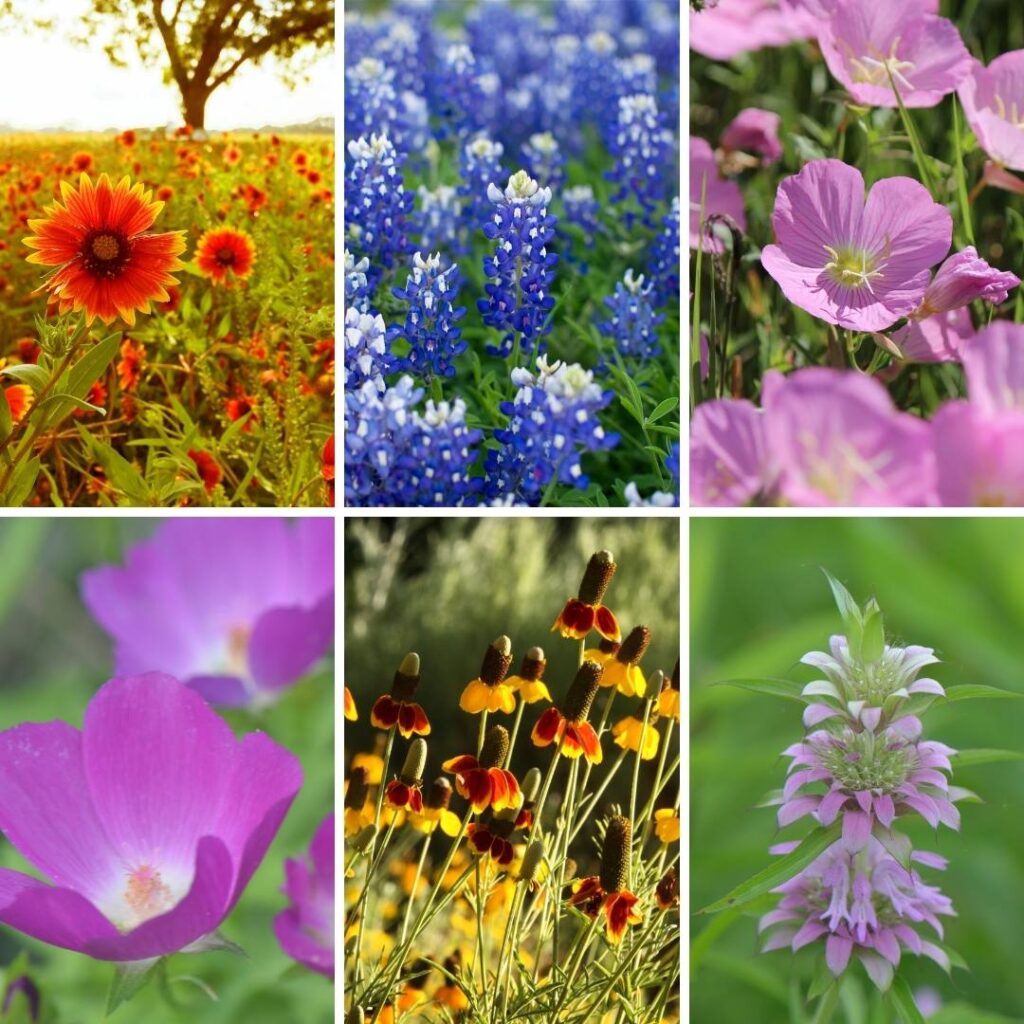
Each year the Texas Department of Transportation sows about 30,000 pounds of wildflower seed along our highways. It is a beautiful sight to see during wildflower season.
The peak season for wildflowers in Texas is April-May. But you don’t have to take a wildflower drive. You can grow them right in your own yard. It is easy to do and a great way to bring your yard to life each spring!
Why Grow Wildflowers in My Yard?
Bring some of the Texas countryside to your own yard! You don’t have to have a full wildflower meadow – a garden of any size will work. Some wildflowers even grow well in pots. Here are a few great reasons to grow Texas wildflowers:
- Wildflowers provide important spring nectar for pollinators such as native bees, butterflies and hummingbirds during the spring migration.
- Your yard will be filled with butterflies!
- A wildflower bed is the perfect replacement for water-guzzling turf grass. Consider removing a portion of your grass and replacing it with a wildflower bed. It requires less mowing!
- Wildflowers require minimal supplemental water once established.
- Common wildflowers make beautiful cut flower bouquets that you can enjoy all summer and spring!
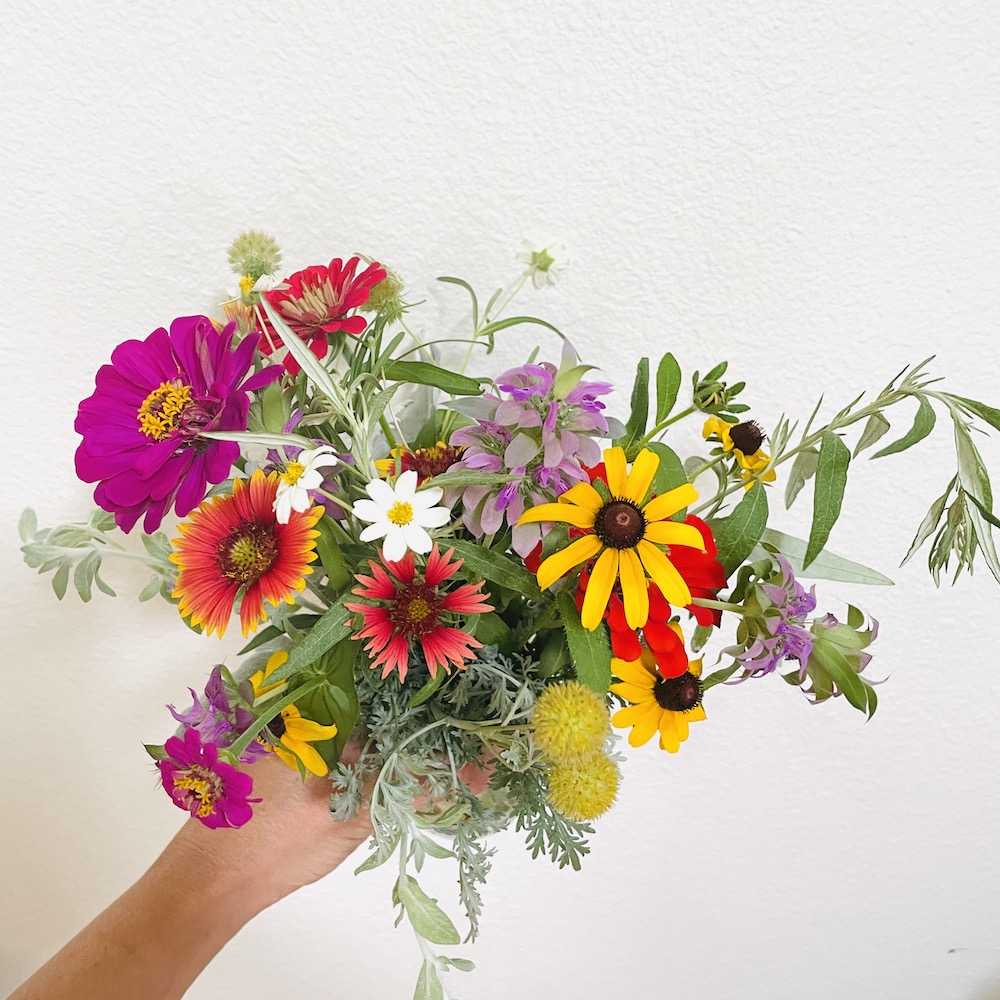
Top 10 Texas Wildflowers to Grow
Here are some of the beautiful wildflowers you can grow at this time of year. I’ve included their common names as well as their scientific names (in parentheses).
1) Texas Bluebonnet (Lupinus texensis)
Starting with the most well-known wildflower in the state of Texas, the Texas Bluebonnet! Our state flower can be found along roadsides starting in March. These sun-loving flowers are bluish purple flower power with a white tip. The individual petals resemble olden-day bonnets!

- Native to: Texas, Louisiana, Oklahoma and Florida
- Bloom period: March-May
- Sun requirements: 8+ hours a day
- Height: <1 ft.
- Butterfly host plant: Host plant for Elfin and Hairstreak butterflies
- When to plant: Bluebonnet seed may need to be scarified. Scatter seeds in fall to have blooms next year! You can plant transplants before Feb. 15 in spring.
2) Indian Blanket (Gaillardia pulchella)
Also known as Blanket Flower and Firewheel, this common Texas wildflower shines with its bright red and yellow blooms. This hardy wildflower has a long bloom period and is one of the easiest wildflowers to grow!
It will create a “blanket” of flowers in good conditions. You can provide supplemental water for a longer bloom period. Just make sure the area has good drainage.
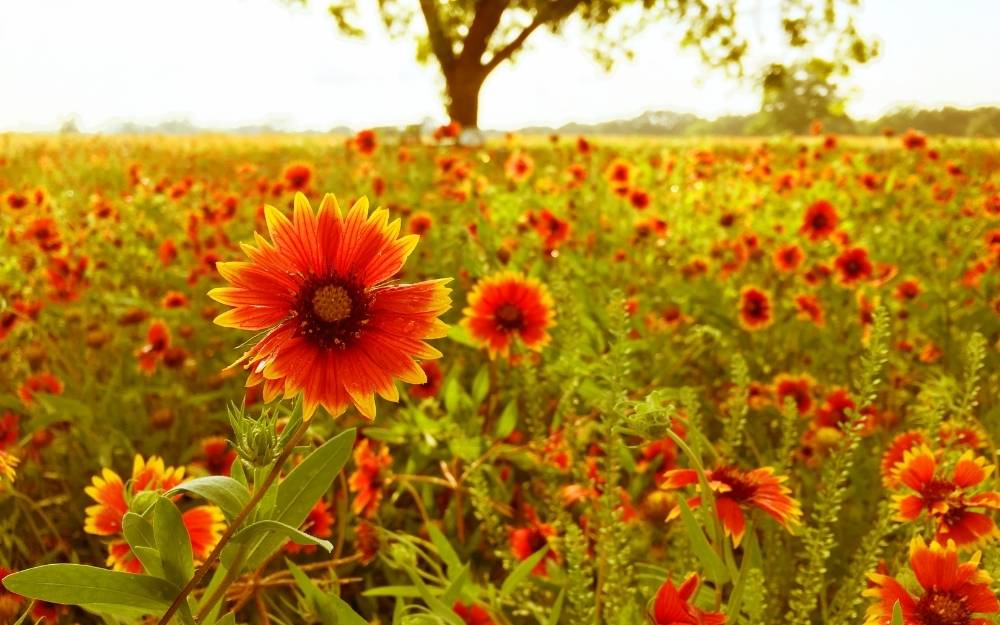
- Native to: Midwest and Southwestern US
- Bloom period: May-August
- Sun requirements: Full sun
- Height: 1-2 ft.
- Butterfly host plant: Gaillardia Flower Moth and Painted Schinia Moth
- When to plant: Sow seeds in the fall. Find transplants at nursery in the spring.
3) Pink Evening Primrose (Oenothera speciosa)
Pink Evening Primrose is just one common name for this plant. It also goes by the names Pink Buttercup and Pink Ladies. Its soft pink hue is one of my favorite flower colors. The flowers tend to open in the evening and close in the morning. Each flower only lasts one day!
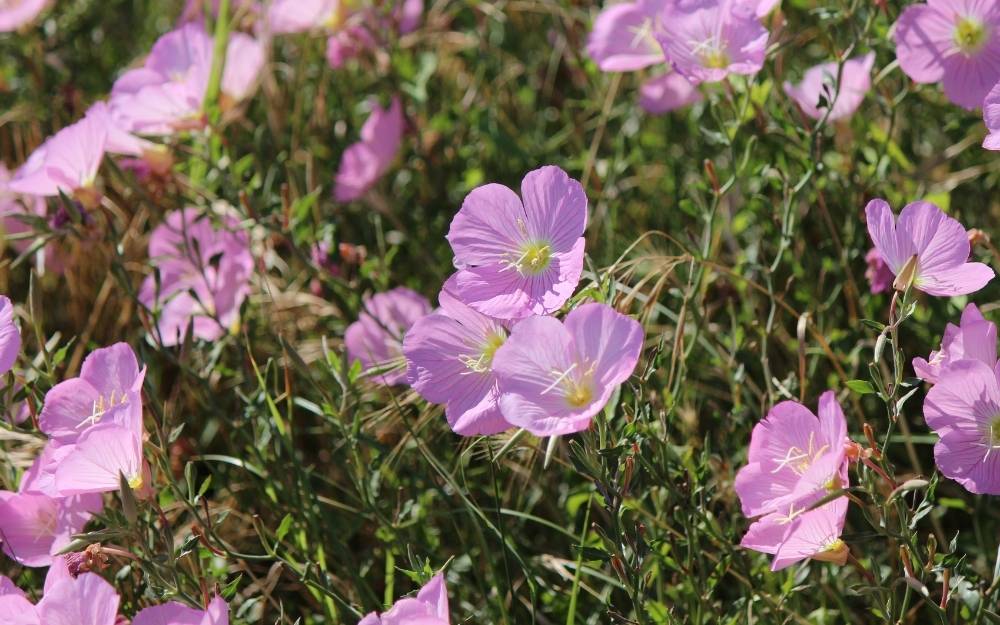
- Native to: Midwest states south to TX
- Bloom period: March-July
- Sun requirements: Full sun
- Height: 1-2 ft.
- Butterfly host plant: N/A
- When to plant: Sow seeds in fall
4) Mexican Hat (Ratibida columnifera)
This bold colored flower resembles a Mexican sombrero. The center disk of the flower rises a couple inches above the red and orange petals. It is a great nectar plant for pollinators and birds enjoy the seeds. Mexican Hat will bloom all summer long!
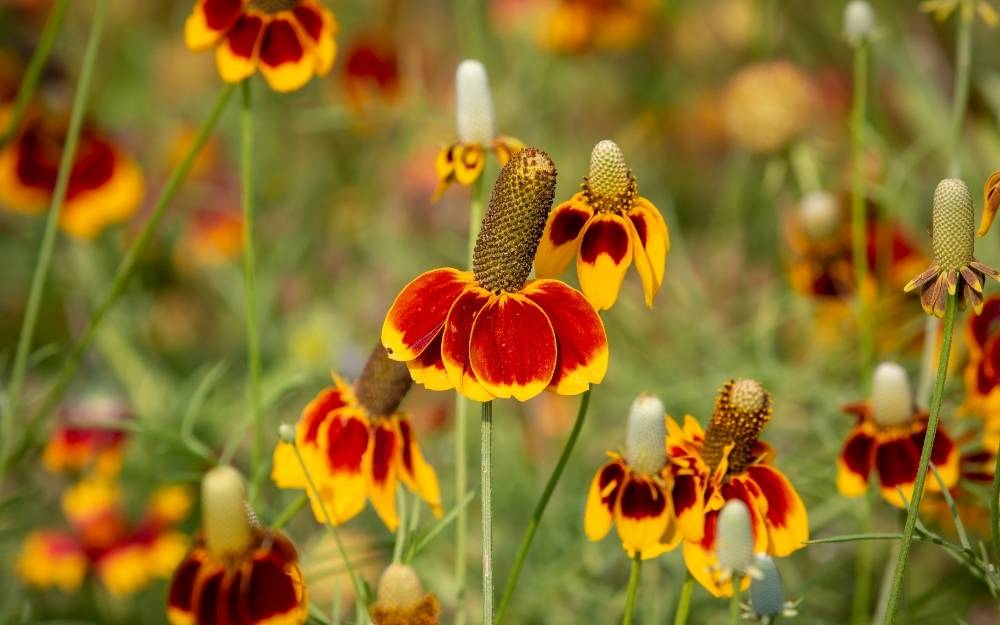
- Native to: Midwest states south to TX
- Bloom period: May-Oct
- Sun requirements: Full
- Height: 1-3 ft.
- Butterfly host plant: N/A
- When to plant: Sow seeds in spring or fall (preferred). You can also find transplants at the nursery.
5) Winecup (Callirhoe involucrata)
Also called a Purple Poppy Mallow, Winecup has the prettiest deep magenta flowers! This low-growing perennial wildflower has a sprawling growth habit and would look pretty trailing over a pot.
Winecup is drought tolerant thanks to its tuber root. It is not deer resistant though, which I have found out the hard way. They love eating it!
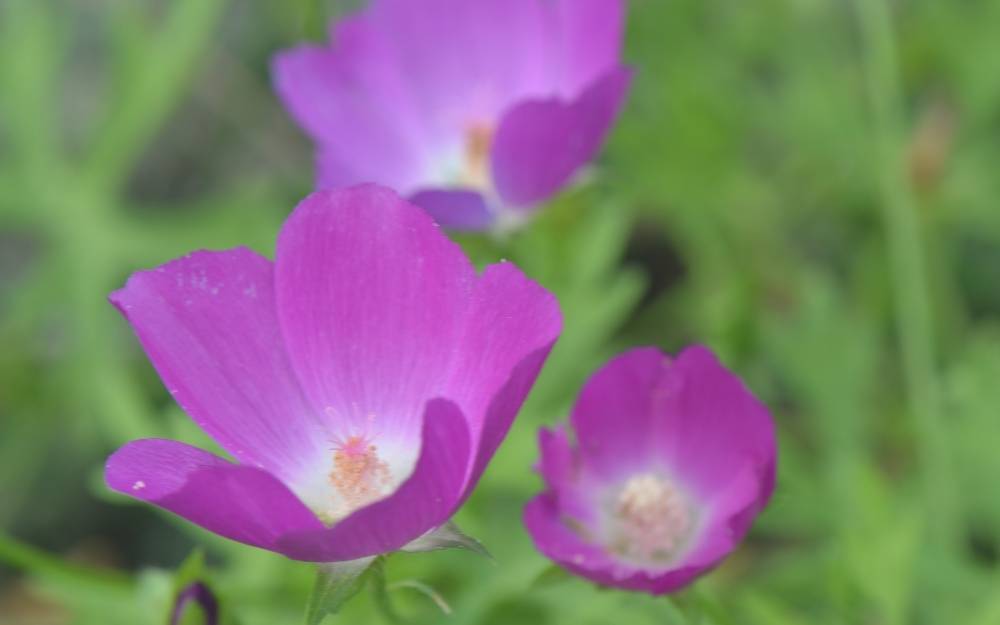
- Native to: Midwest states (TX to ND)
- Bloom period: Feb-June
- Sun requirements: Sun-Dappled Sun
- Height: 1 ft.
- Butterfly host plant: Gray hairstreak butterfly
- When to plant: Scatter seeds in fall
6) Lemon Mint (Monarda citriodora)
Also referred to as Horse Mint or Lemon Bee Balm, Lemon Mint has a minty smell to its leaves which helps keep the deer away! Its pretty stacked purple flowers are enjoyed by bees, butterflies, and hummingbirds. Lemon Mint can form large colonies of flowers.
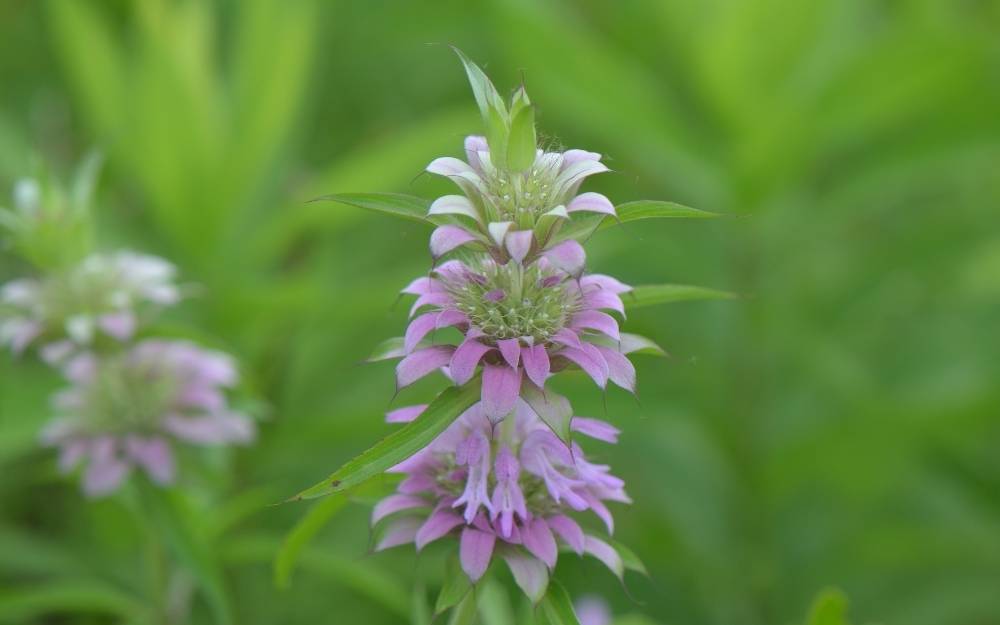
- Native to: Southern US
- Bloom period: May-July
- Sun requirements: Full – dappled sun
- Height: 1-3 ft.
- Butterfly host plant: Orange Mint and Hermit Sphinx Moths
- When to plant: Scatter seeds in fall (preferred) or early spring
7) Plains Coreopsis (Coreopsis tinctoria)
One of the easiest native wildflowers to grow, Plains Coreopsis has bright colors similar to Mexican Hat flowers. It prefers moist soil so performs best in years with more rain.
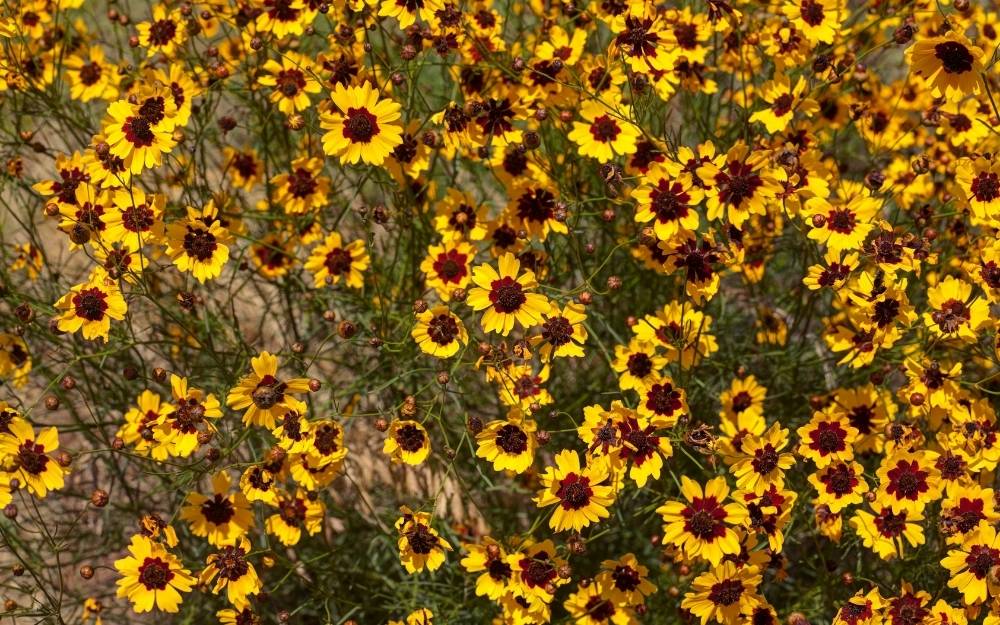
- Native to: Midwest plains states south to TX
- Bloom period: Feb-June
- Sun requirements: Full to dappled sun
- Height: 1 ft.
- Butterfly host plant: N/A
- When to plant: Sow seeds in spring or fall.
8) Butterfly Weed (Asclepias tuberosa)
If you’re going to be creating a wildflower bed, make sure to include some milkweed for Monarchs! Like the other species of milkweed, Butterfly Milkweed is used by Monarchs as their host plant.
This perennial wildflower is also an incredible nectar plant for pollinators drawn to its bright orange fragrant blooms!
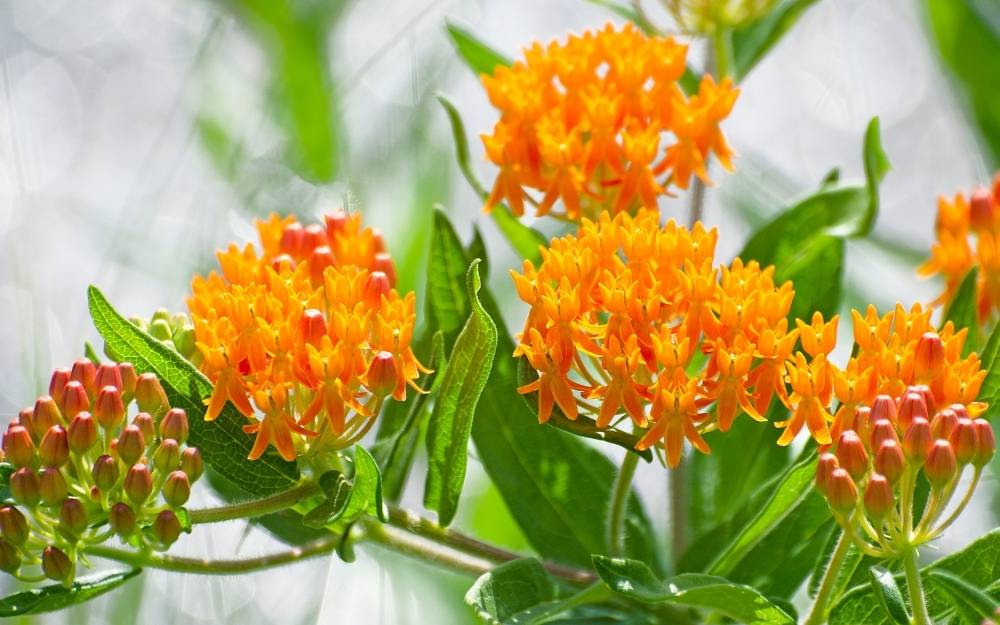
- Native to: East Coast west to Colorado
- Bloom period: May-Sept
- Sun requirements: Full sun
- Height: 1-2 ft.
- Butterfly host plant: Monarch, Queen, and Gray Hairstreak butterflies
- When to plant: Cold stratify seeds in winter and plant in spring. Try finding transplants at the nursery.
9) Maximilian Sunflower (Helianthus maximiliani)
Want to add some height to your wildflower garden? Then be sure to include some Maximilian Sunflower, which can grow to over 6 ft. tall! Sunflowers are important butterfly host plants. In addition, birds love their seeds.
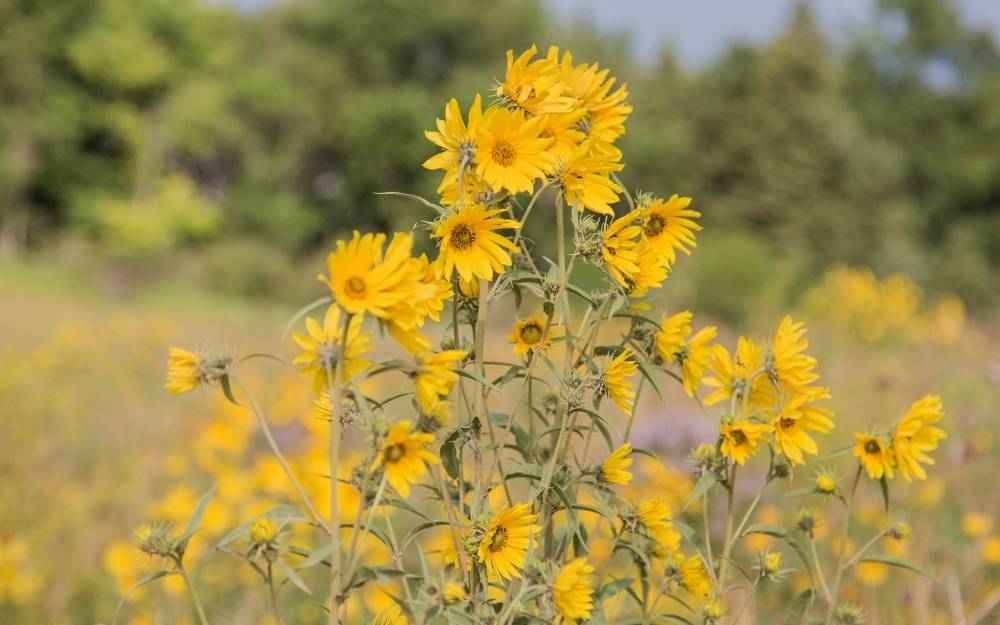
- Native to: Midwest plains states south to TX
- Bloom period: Aug-Nov
- Sun requirements: Full
- Height: 4-6 ft. (tall!)
- Butterfly host plant: Bordered Patch and Silvery Checkerspot butterflies
- When to plant: Cold stratify seeds in winter and plant in spring
10) Cardinal Flower (Lobelia cardinalis)
One more neat Texas wildflower to add height to your garden. The bright red Cardinal Flower is a striking addition! This perennial wildflower likes rich, moist soil so it may be best for a garden bed rather than a more hands off wildflower meadow. Hummingbirds love its red blooms!
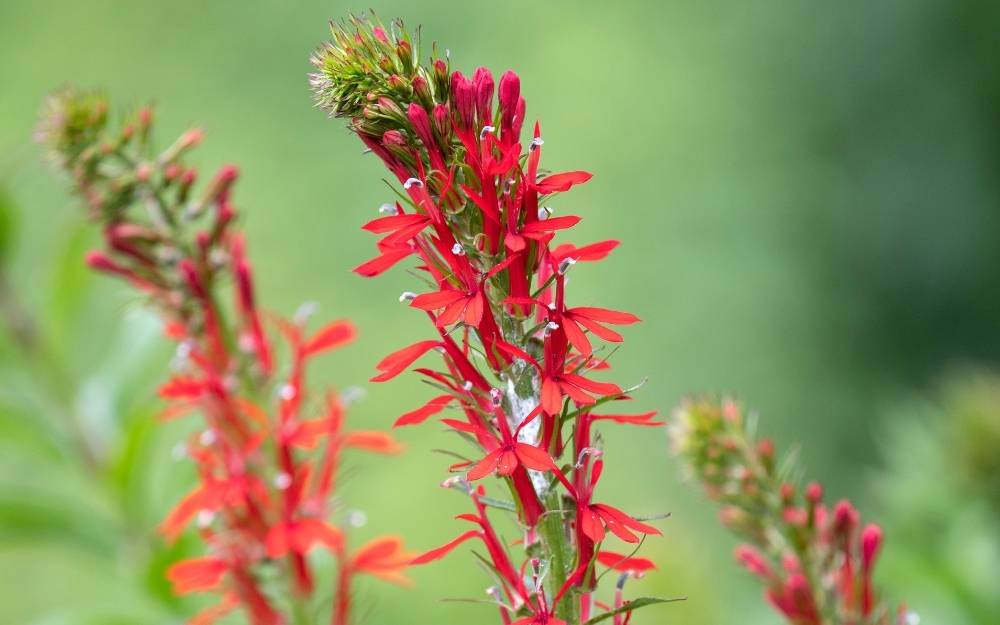
- Native to: Most of US except upper Western states
- Bloom period: June-Oct
- Sun requirements: Sun-Part Shade
- Height: 1-4 ft.
- Butterfly host plant: N/A
- When to plant: Cold stratify in refrigerator and plant in spring
Download the Free PDF: Texas Wildflowers
I created a handy one-page PDF for you to print out. It includes a thumbnail photo of each species of Texas wildflowers along with both its common and scientific name, sun requirements, and other helpful growing info. Get it here:
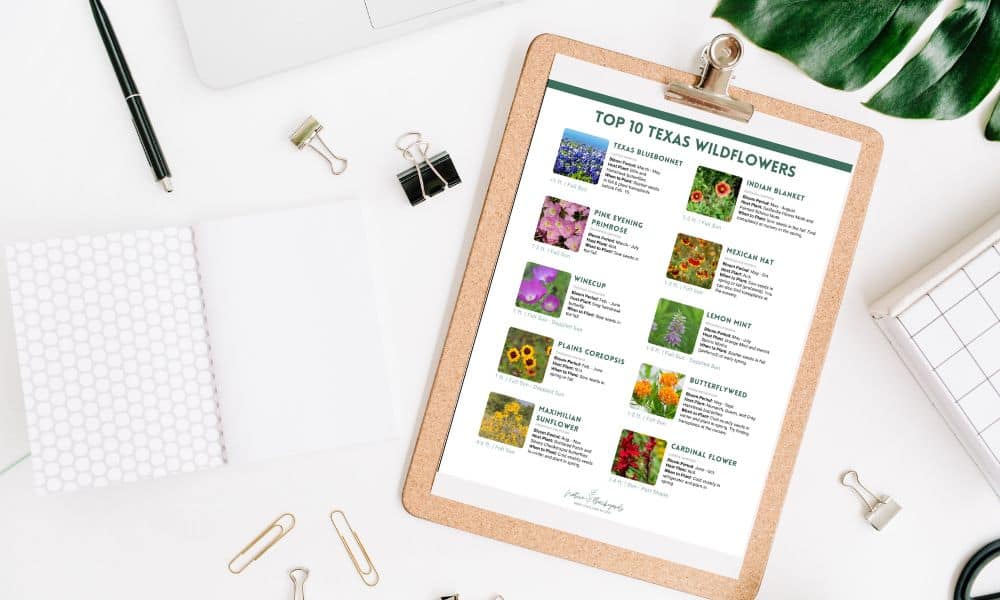
Texas Wildflowers to Grow By Color
Want to create a Texas wildflower bed full of your favorite color? It is possible! Just sow seeds from one of the following categories of species of wildflowers:
Yellow Texas Wildflowers
- Coreopsis (Coreopsis tinctoria),
- Black-eyed Susan (Rudbeckia hirta)
- Huisache Daisy (Amblyolepis setigera)
- Chocolate Daisy (Berlandiera lyrata)
- Common Sunflower (Helianthus annuus)
- Maximilian Sunflower (Helianthus maximiliani)
Pink Texas Wildflowers
- Pink Evening Primrose (Oenothera speciosa)
- Winecup (Callirhoe digitata)
- Texas Thistle (Cirsium texanum)
- Mountain Pink (Centaurium beyrichii)
- Obedient Plant (Physostegia pulchella)
Blue / Purple Texas Wildflowers
- Texas Bluebonnets (Lupinus texensis)
- Lemonmint (Monarda citriodora)
- Texas Bluebell (Eustoma exaltatum)
- Gayfeather (Liatris spp.)
- Blue-Eyed Grass (Sisyrinchium spp.)
- Prairie Verbena (Glandularia bipinnatifida)
Red Texas Wildflowers
- Cardinal Flower (Lobelia cardinalis)
- Standing Cypress (Ipomopsis rubra)
- Cedar Sage (Salvia roemeriana)
- Indian Paintbrush (Castilleja spp.)
- Indian Blanket (Gaillardia pulchella)
White Texas Wildflowers
- White Prickly Poppy (Argemone albiflora)
- Blackfoot Daisy (Melampodium leucanthum)
- Fleabane (Erigeron philadelphicus)
How Do You Grow Wildflowers Successfully?
A key factor for growing wildflowers is giving them full sun, which means at least 6 hours of direct sun a day. Most wildflowers can handle a variety of soil types as long as the soil is well drained.
Starting a wildflower bed for the first time? Be sure to check out these tips:
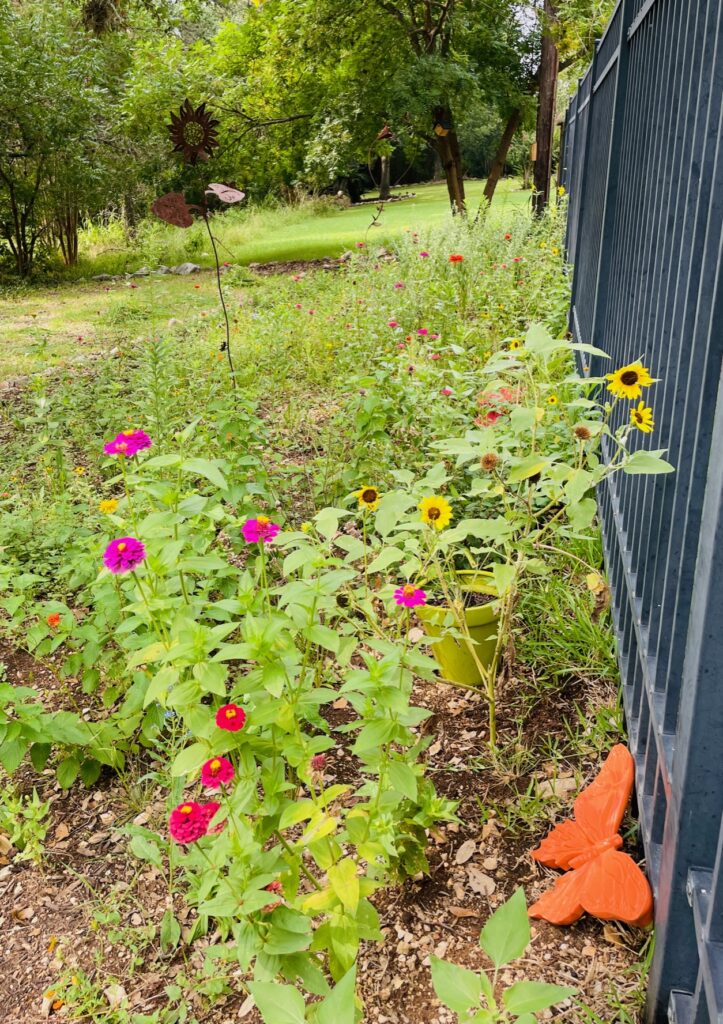
Where Can You Buy Wildflower Seeds?
My favorite source for Texas wildflower seeds is Native American Seed, located in Junction, TX. You can purchase seeds of individual wildflower species, as well as seed mixes. Here are links to seeds you can purchase for the top 10 wildflowers listed above:
Individual Wildflower Seed Packages
- Bluebonnet seeds
- Indian Blanket seeds
- Pink Evening Primrose seeds
- Mexican Hat seeds
- Wine Cup seeds
- Lemon Mint seeds
- Plains Coreopsis seeds
- Butterflyweed seeds
- Maximilian Sunflower seeds
- Cardinal Flower seeds
Texas Wildflower Seed Mixes
Check out my top online sources for native wildflower seed mixes. They include mixes of Texas native wildflowers as well as wildflowers native to other regions of the U.S.:
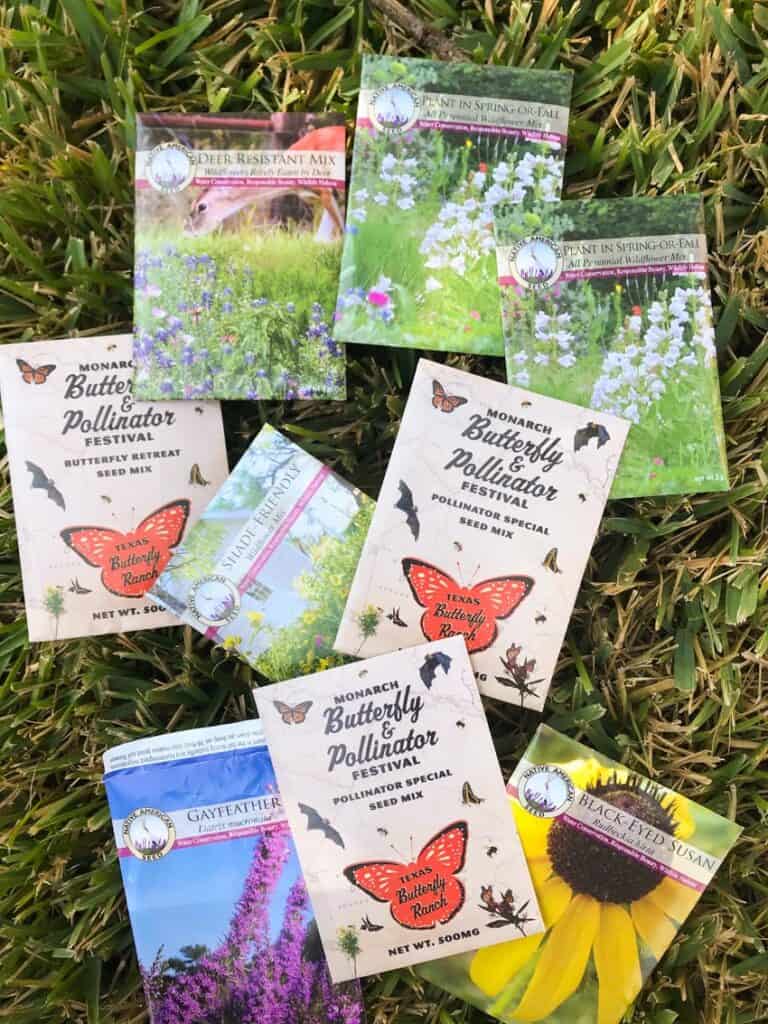
Where Can You See Native Texas Wildflowers?
Want to see wildflowers in addition to growing them? Some of the best places to see Texas wildflowers are right along the roadside. Here in San Antonio, they are abundant along Highway 1604 near where I live starting in early spring and going through late summer.
Here are some of my favorite places to see Texas Wildflowers:
- Texas Hill Country region scenic drives – such as Willow City Loop, and Highway 290 between Fredericksburg and Johnson City, are popular for roadside wildflowers. Find more routes here.
- Lady Bird Johnson Wildflower Center in Austin – the Wildflower Center is named after the former First Lady who championed wildflowers (they have a great gift shop too!).
- Wildseed Farms in Fredericksburg – Wildseed Farms and other wildflower farms that are open to visitors make for a fun weekend outing!
- Walking trails in state and city parks – head outside with a wildflower guide and see what you can spot!
Best Texas Wildflower Books
These guides are my go-to references for learning about Texas native wildflowers (affiliate links):

- Wildflowers of Texas Hill Country – I consider this THE Bible of Texas wildflowers. It is so fun to page through!
- Wildflowers of Central Texas – a handy laminated pocket guide.
- Texas Wildflower Wheel – not a book, but a wheel! It is a fun way to help you recognize common wildflower seedlings.
- Legends and Lore of Texas Wildflowers – learn about the folklore, medicinal uses, and other cool history behind these wildflowers.
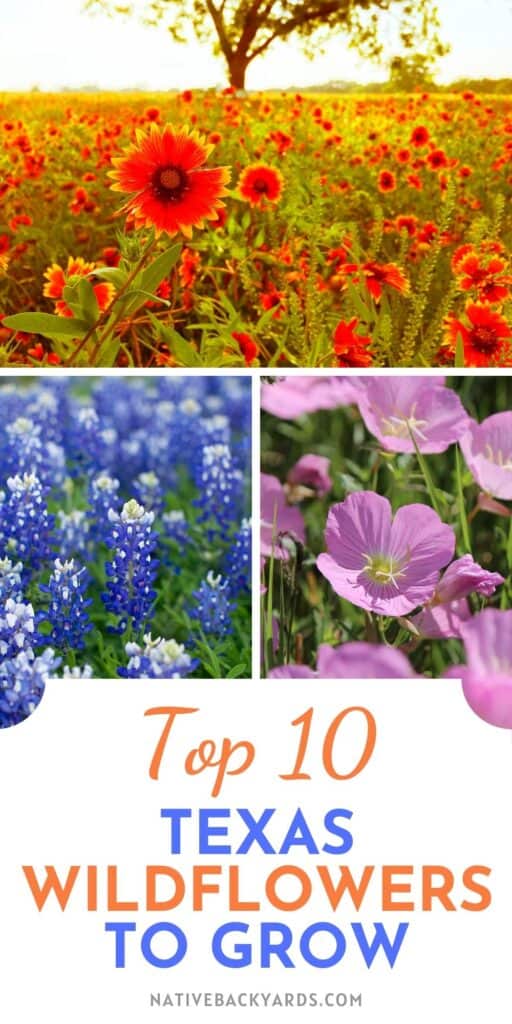
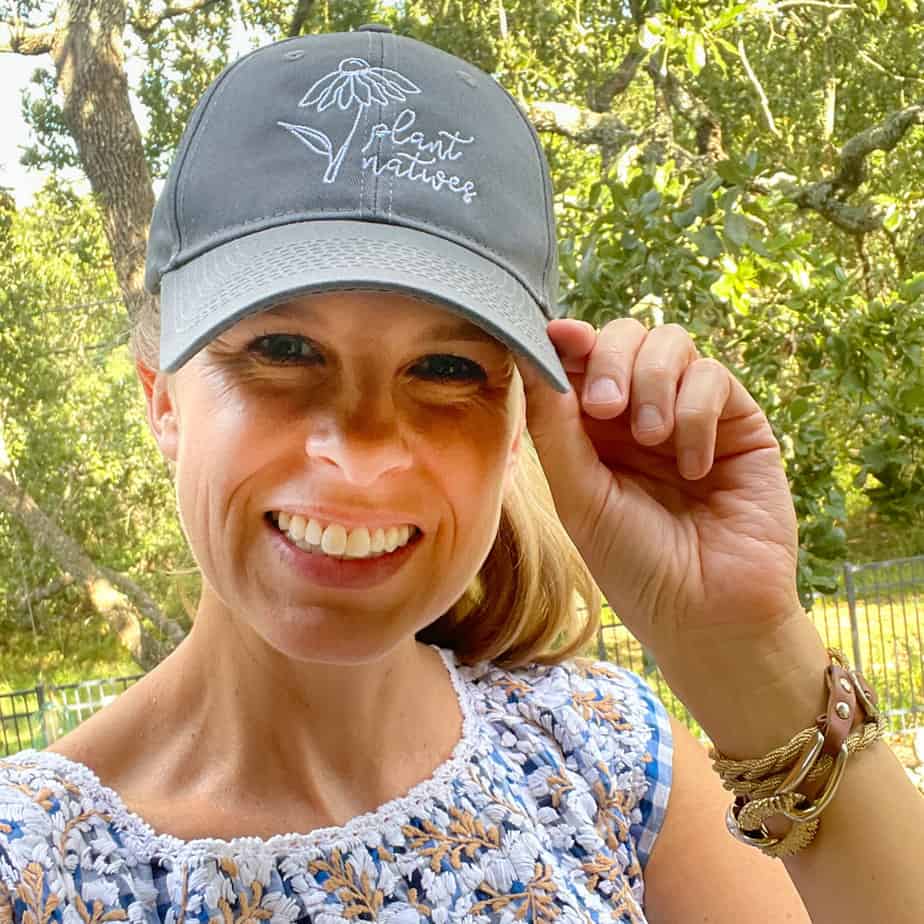
Welcome to Native Backyards! I’m Haeley from San Antonio, Texas, and I want to help you grow more native plants.
I have seen firsthand how the right plants can bring your yard to life with butterflies, bees, and birds. I’ve transformed my yard with Texas natives and I’m excited to share what I’ve learned with you.
Join my newsletter here! – each week I’ll send you helpful tips to make your native plant garden a reality!
Want to learn more about me and my garden? Check out my About page!
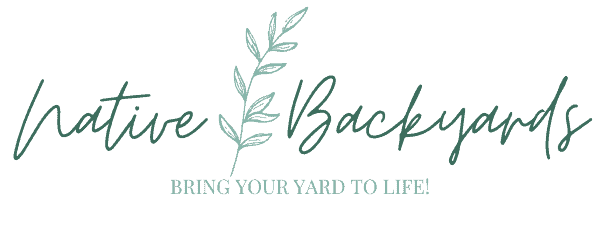
I plan on move to Murfreesboro. TN in a couple of weeks
Which wildflowers do you suggest I plant?.
Thank you for your suggestions.
Hi Deborah! Good luck with your move! I would suggest these TN natives: Indian Blanket (Gaillardia pulchella), Lemon Beebalm (Monarda citriodora), Butterfly Weed (Asclepias tuberosa), Black Eyed Susan (Rudbeckia hirta), and Purple Coneflower (Echinacea purpurea).
We live east of Austin on Blackland Prairie soil. I planted wildflower seeds in two oval landscape patches last fall. The flowers have been beautiful this spring, but are dying back in the summer heat. What should I do now to provide some color in those oval patches during the rest of the growing season while giving the wildflower seeds space to germinate?
Hi JJ, I apologize for the delayed response to your wildflower question. The excessive heat and lack of rain this summer has made blooms hard to come by! My wildflower bed did not produce blooms near as well this year as last year. A few wildflowers that seem to do well in the heat (and bloom longer into the summer) are Purple Coneflower, Annual Sunflower, Mealy Blue Sage, and Butterfly Weed. If you don’t have these in your oval beds, I would sow some seeds in the fall so you can enjoy them next year!
A little late here, but I suggest you contact the Native Plant Society of Texas and find your local chapter to get the answer to that question. They have native plant sales and classes you can take that are specifically for your area. Blackland Prairie should give you all kinds of options for what to do! They also organize events to clean up and expand parks featuring native plants, which is great.
https://npsot.org/wp/
Here’s the link to the local chapters page, along with an ecoregion map to show you which one is where. Good luck and enjoy — I’ve really loved getting in touch with these people and it’s so great to know your work is not just impacting your own back yard, but a wider part of the state.
This is great, but why aren’t you promoting NPSOT (Native Plant Society of Texas), which offers classes that lead to master native landscaping certification? Or native plant societies in other states? They need all the support they can get, and they’re working for everyone, not just personal profit.
Hi Aline, I’m a big advocate of NPSOT and serve on the board of our San Antonio chapter! I often encourage my readers to seek out their local chapter and provide them with the great plant lists created by NPSOT for their region.
Good call on providing the link to Native American Seed! Their wildflower seeds are great and for anyone interested in seeding your lawn (or even part of it) with native turf, they have native Texas grass seed and seed blends that are wonderful. We planted their Sun Turf blend (buffalograss and blue grama) on an easement strip and it’s great- runs about five inches high, doesn’t need mowing, and when the wind blows, it ripples and looks so beautiful. No mowing and no watering. I’m all for it!
*I’m not affiliated with Native American Seed; I came across their products a few years ago and have been really thrilled with the quality of what I’ve gotten from them.